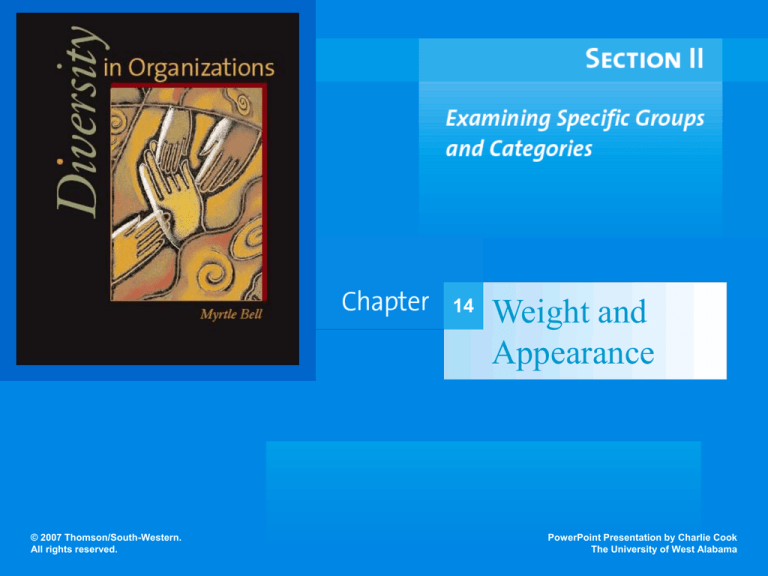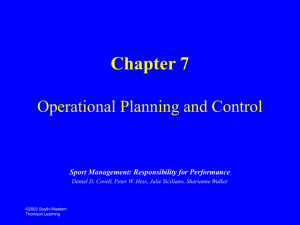
14
© 2007 Thomson/South-Western.
All rights reserved.
Weight and
Appearance
PowerPoint Presentation by Charlie Cook
The University of West Alabama
Chapter Objectives
After completing this chapter, readers should understand
weight and appearance as they relate to diversity in
organizations. They should specifically be able to
discuss increasing weight levels in the United States
and other populations around the world.
understand the U.S. legislation relevant to weight and
appearance discrimination.
describe employment experiences of overweight
people and gender differences in employment
outcomes based on weight and appearance.
explain how weight and appearance are relevant
aspects of diversity and consider whether the obese
should be a protected class.
© 2007 Thomson/South-Western. All rights reserved.
14–2
Chapter Objectives
After completing this chapter, readers should understand
weight and appearance as they relate to diversity in
organizations. They should specifically be able to
discuss legitimate health consequences of obesity
and employers’ concerns about increased health-care
and other costs associated with obesity.
discuss how seemingly legitimate appearance
requirements may result in illegal discrimination.
develop methods that can be used to increase
acceptance of people of varying dimensions, with or
without the presence of widespread legislation.
© 2007 Thomson/South-Western. All rights reserved.
14–3
Population
• Obesity and overweight are increasing in
prevalence around the world.
• Reasons for this increase include
The increased transportation reduced walking
The shift from active to sedentary jobs and lifestyles
Increased availability of fatty high-calorie fast food
• Research indicates that weight is controlled by
social, behavioral, cultural, physiological,
metabolic, and genetic factors.
© 2007 Thomson/South-Western. All rights reserved.
14–4
Education, Employment Levels, Types, and
Income
• People of various weights will have similar and
different education levels, employment levels,
types, and income levels.
There are fewer fat people at higher levels and
disproportionately more fat people at lower levels.
Fat people are likely to be unemployed and to remain
unemployed longer than people who are not fat.
All things being equal, fat workers fare worse than
those who are not fat, particularly fat women.
© 2007 Thomson/South-Western. All rights reserved.
14–5
Effects of Attractiveness of Appearance on
Employment and Income
• Research Findings
Attractiveness was positively related to hiring,
performance evaluations, and promotion, for both
men and women.
Providing raters with job-relevant information does not
reduce the attractiveness bias.
Height was significantly related to earnings for both
men and women, and advantages for tall people were
stable over the course of participants’ careers.
© 2007 Thomson/South-Western. All rights reserved.
14–6
Legislation Relevant to Weight and
Appearance
• Presently, no Federal legislation prohibits weight
discrimination alone.
• The ADA and Weight
If an employer assumes that an applicant’s weight will
impede the applicant’s ability to perform a job and
makes a negative employment decision on the basis
of this perception, the applicant could have a claim
under the ADA.
The ADA covers persons who are morbidly obese.
© 2007 Thomson/South-Western. All rights reserved.
14–7
State and Local Statutes Prohibiting Weight
and Appearance Discrimination
• Cities, states, and localities prohibit weightbased discrimination directly, or as a
consequence of prohibitions of appearancerelated discrimination.
Professionalism and cleanliness are not prohibited
when such requirements are necessary for
reasonable business purposes and are consistently
applied.
© 2007 Thomson/South-Western. All rights reserved.
14–8
Should Size Discrimination be Prohibited by
Federal Law?
• Does overt discrimination (in employment, housing,
public accommodations, and other areas) and lack of
controllability of weight warrant its inclusion as a
protected class?
Given the pervasiveness of weight discrimination, the increased
risks for health conditions associated with excess weight, and
the difficulty in losing weight and maintaining weight loss, it is
possible that weight should be a federally protected class,
similar to sex, race, ethnicity, and disability.
© 2007 Thomson/South-Western. All rights reserved.
14–9
Effects of Weight on Health and on Costs to
Employers
• Although some overweight people are quite
healthy, the correlation between excess weight
and various severe health problems is clear.
Obese and overweight workers are estimated to lose
nearly 40 million work days and cost employers 15%,
20%, and 55% more in prescription drug, long-term
disability, and short-term disability costs, respectively,
with greater costs as the weight level increases.
© 2007 Thomson/South-Western. All rights reserved.
14–10
TABLE 14.1 Mean Costs of Overweight and Obesity at General Motors
Source: Adapted from Grossman R. J. (2004, March), “Countering a Weight Crisis.” HR Magazine, p. 45.
© 2007 Thomson/South-Western. All rights reserved.
14–11
Is it the Fat, the Health, or the Stigma of
Overweight?
• Bases for Fat Discrimination
The widespread dislike for fatness
The clear visibility of fatness
The perceived association of excess weight with
many negative personal attributes
The lack of widespread sanctions for discrimination
on the basis of fat all contribute to continued fat
discrimination.
• Stigmatization results from deviance from
preferred attributes of thinness rather than
normal attributes.
© 2007 Thomson/South-Western. All rights reserved.
14–12
TABLE 14.2 Appearance Concerns and Relevant Federal Legislation
© 2007 Thomson/South-Western. All rights reserved.
14–13
Organizational Recommendations
• Considerations for Employers:
What is the legitimacy of health, absence, and cost-
related concerns for their employee population.
Are similar concerns expressed regarding other
health issues?
Do people with other health issues that are viewed as
controllable (e.g., pregnancy, smoking-related lung
cancer) experience similar treatment?
By focusing on health, rather than weight, employers
may find a healthier workplace overall, for all
employees.
© 2007 Thomson/South-Western. All rights reserved.
14–14
Organizational Recommendations (cont’d)
• Considerations for Employees:
When faced with or observing weight-based
stereotyping or discrimination, employees should
address this with valid information about weight and
the characteristics of those who are overweight.
Overweight employees should consider and model
behaviors of other nondominant groups in the face of
overt social and employment discrimination.
Those who are overweight should also take care to
monitor their health; with exercise and proper eating,
one may be healthy in spite of excess weight.
© 2007 Thomson/South-Western. All rights reserved.
14–15
Individual and Organizational Recommendations
to Minimize Appearance Discrimination
• Employers should carefully scrutinize appearance
preferences and requirements for potential for various
types of discrimination.
Is the employee or applicant neat? Are his or her clothes ironed,
of sufficient length, and an appropriate size?
Is the employee or applicant’s clothing clean?
Is the requirement necessary to the safe operation of the
business?
Is resistance to the employee or applicant’s appearance a
situation of race, cultural, ethnic, gender, age, social, or other
bias?
If religious discrimination is a possibility, could the employee’s
request be reasonably accommodated?
© 2007 Thomson/South-Western. All rights reserved.
14–16
Key Term
• Stigma
© 2007 Thomson/South-Western. All rights reserved.
14–17







